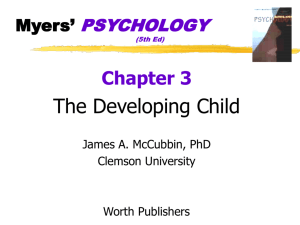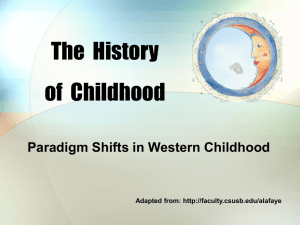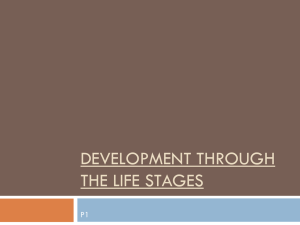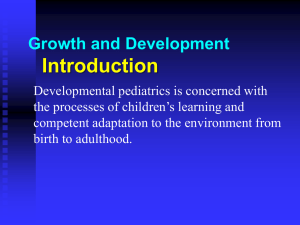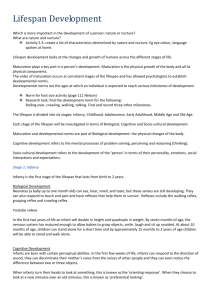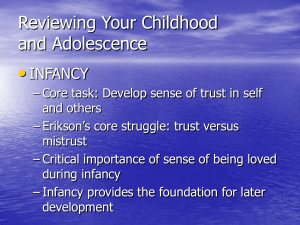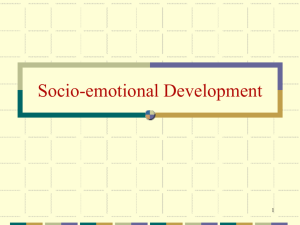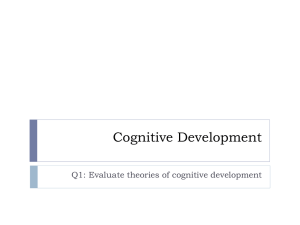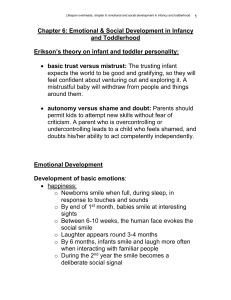Module 8revised
advertisement
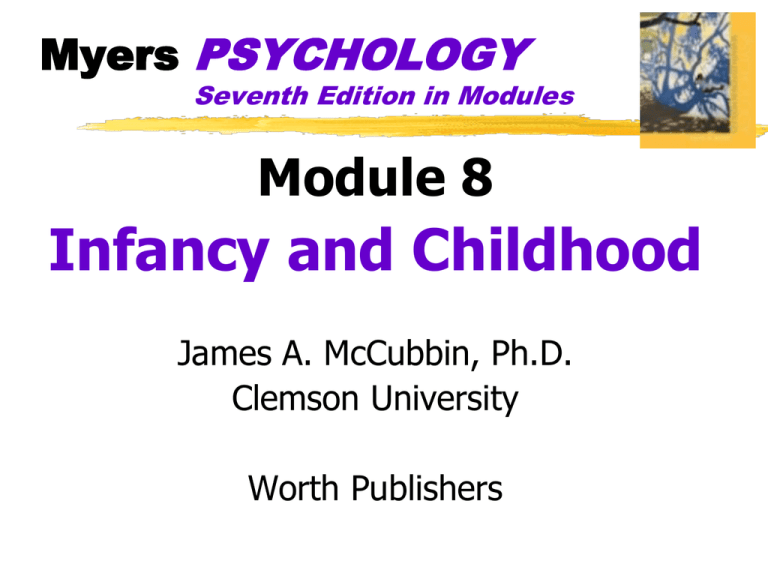
Myers PSYCHOLOGY Seventh Edition in Modules Module 8 Infancy and Childhood James A. McCubbin, Ph.D. Clemson University Worth Publishers Infancy and Childhood: Physical Development Maturation biological growth processes that enable orderly changes in behavior relatively uninfluenced by experience At birth 3 months 15 months Cortical Neurons Infancy and Childhood: Physical Development Babies only 3 months old can learn that kicking moves a mobile--and can retain that learning for a month (RoveeCollier, 1989, 1997). Cognitive Development z Developmental psychologists try to describe how children think and evaluate the world. z The work of Piaget had a great impact in this area. z He developed a theory of cognitive development. Infancy and Childhood: Cognitive Development Cognition all the mental activities associated with thinking, knowing, remembering, and communicating Schemas are the frameworks that we use to organize and interpret information. Infancy and Childhood: Cognitive Development Assimilation interpreting one’s new experience in terms of one’s existing schemas Accommodation adapting one’s current understandings (schemas) to incorporate new information Schema: Dogs are four legged animals Scenario: child sees a cat Assimilation z The child thinks that the cat is a dog. Accommodation z The child changes their schema to include both dogs and cats as having four legs. Schema – Everything with wheels is a truck. Scenario – Child is presented with a bicycle. Assimilation z He thinks the bicycle is a type of truck. Accommodation z He changes his concept of things with wheels to include trucks and bikes. Piaget’s Stages of Cognitive Development Typical Age Range Description of Stage Developmental Phenomena Birth to nearly 2 years Sensorimotor Experiencing the world through senses and actions (looking, touching, mouthing) •Object permanence •Stranger anxiety About 2 to 6 years Preoperational Representing things with words and images but lacking logical reasoning •Pretend play •Egocentrism •Language development About 7 to 11 years Concrete operational •Conservation Thinking logically about concrete •Mathematical events; grasping concrete analogies transformations and performing arithmetical operations About 12 through adulthood Formal operational Abstract reasoning •Abstract logic •Potential for moral reasoning Infancy and Childhood: Cognitive Development Object Permanence the awareness that things continue to exist even when not perceived Characteristics of the sensorimotor stage z The child acts on the environment by knocking down blocks, making sounds, finding toes. z The child sees an object and reaches. z The child realizes that objects still exist although the objects is no longer seen. z The child cries when the parent is no longer present. This is called stranger anxiety. Infancy and Childhood: Cognitive Development Baby Mathematics Shown a numerically impossible outcome, infants stare longer (Wynn, 1992) 4. Possible outcome: Screen drops, revealing one object. 1. Objects placed in case. 2. Screen comes 3. Object is removed. up. 4. Impossible outcome: Screen drops, revealing two objects. Infancy and Childhood: Cognitive Development Conservation the principle that properties such as mass, volume, and number remain the same despite changes in the forms of objects Conservation Experiments z Conservation of liquid quantity z Conservation of mass z Conservation of area z Conservation of number Infancy and Childhood: Cognitive Development Egocentrism the inability of the preoperational child to take another’s point of view Theory of Mind people’s ideas about their own and others’ mental states- about their feelings, perceptions, and thoughts and the behavior these might predict Autism a disorder that appears in childhood Marked by deficient communication, social interaction and understanding of others’ states of mind Characteristics of the preoperational stage z The child starts to represent the world internally through language. z The child cannot take another point of view. z The child thinks all objects have life. z The child thinks human beings created everything. z The child uses inaccurate logic by assuming that the characteristics of a specific idea can be applied to a similar idea – birds fly – airplanes fly – birds must be airplanes. z The child classifies objects by only one trait – typically color. Concrete Operational Stage z The child can now understand simple operations performed on concrete reality. z They have a mental schema for quantity, mass, volume and number. z Change in shape does not affect quantity. z They can comprehend math transformations. Characteristics of the concrete operational stage z The child begins to understand that objects can change shape without other changes in the characteristics. z The child understands and performs operations that go in the other direction. z The child draws conclusions from a number of specific facts. z The child classifies objects into larger classes of objects. z The child classifies by a number of characteristics. Formal Operational Stage z z z z Occurs around adolescence Manipulate complex mental representation Think in terms of abstractions Metacognition Characteristics of the Formal Operational stage z The child thinks abstractly. z The child hypothesizes. z The child can get specific facts from a generalization. Assessing Piaget Pros z We learn best when we build on what we already know. z New reasoning abilities require previous abilities. z Children don’t reason with adult logic. Cons z He underestimated children. z Development is continuous not in stages. z Children go through the stages more rapidly than was estimated. Examples z 1. Jake looks at a string of plastic beads; six are white and ten are blue. Jake is asked how many white beads there are and answers correctly – six. He is then asked how many plastic beads there are and he answers ten. • Stage • Age • Concept Social Development Stranger Anxiety fear of strangers that infants commonly display beginning by about 8 months of age Attachment an emotional tie with another person shown in young children by their seeking closeness to the caregiver and displaying distress on separation 2. Carrie can solve an algebraic equation. Stage – age - concept z 3. Pierre loves to play peek-a-boo. He laughs when someone puts a blanket over his face and then pulls it away. y Stage – age – concept. z 4. Paul sees a piece of ribbon tied in a bow. He unties the bow and stretches it to its full length. Which is longer – they are the same. y Stage –age - concept Social Development Harlow’s Surrogate Mother Experiments Monkeys preferred contact with the comfortable cloth mother, even while feeding from the nourishing wire mother Social Development Critical Period an optimal period shortly after birth when an organism’s exposure to certain stimuli or experiences produces proper development Imprinting the process by which certain animals form attachments during a critical period very early in life Social Development Monkeys raised by artificial mothers were terror-stricken when placed in strange situations without their surrogate mothers. Attachment z Work of Mary Ainsworth z Studied attachment between infants and mothers z 3 types of attachment y Secure attachment y Avoidant attachment y Anxious attachment In all studies she observed infants’ reactions when placed into a strange, novel situation when their parent left them alone for short period of time and then returned. Secure attachment z These infants usually appear active and happy. z They are willing to explore a new room if the mother is present. They warm up quickly to a stranger who talks with the mother. z They are not greatly disturbed if the mother is absent for a brief period of time. z When the mother returns to the room the infant becomes anxious and runs to the mother’s side. Avoidant attachment z These infants are not even upset by separation from the mother. They do not cry when she leaves. z When she returns, the infant may ignore her or react casually to her presence. The infant may even avoid her. z If the infant is distressed they will not seek contact. Anxious attachment z These infants do not explore a strange room full of toys. z They cry and cling to the mother even before being separated from her. z They act suspicious of strangers and get very upset if the mother leaves the room. z When she returns they pout or even cry. z They show extreme stress when she leaves but resist being comforted when she returns. Social Development Percentage of infants 100 who cried when their mothers left 80 Groups of infants left by their mothers in a unfamiliar room (from Kagan, 1976). Day care 60 40 Home 20 0 3.5 5.5 7.5 9.5 11.5 13.5 20 Age in months 29 Social Development Basic Trust (Erik Erikson) a sense that the world is predictable and trustworthy said to be formed during infancy by appropriate experiences with responsive caregivers Self-Concept a sense of one’s identity and personal worth Social Development: ChildRearing Practices Authoritarian parents impose rules and expect obedience “Don’t interrupt.” “Why? Because I said so.” Permissive submit to children’s desires, make few demands, use little punishment Authoritative both demanding and responsive set rules, but explain reasons and encourage open discussion Parenting examples z For each scenario determine an authoritarian response, a permissive response, and an authoritative response. z 1. Your 7 year old daughter wants to sleep over at her friend’s house with three other girls. You have met the friend but not her parents. z 2. You decide to run away from home. You are caught just as you are heading out the door. z 3. Your 4 year old has coloured on the wall for the first time. z 4. You have missed your curfew by 30 minutes. Developmental Issues z There are three major issues in the study of developmental psychology. z 1. Continuity and stages y How is our development continuous, and how do we develop in stages? z 2. Stability and change y What remains stable across our development, and how do we change? z 3. Nature and nurture y How does the interaction of nature and nurture affect development?
